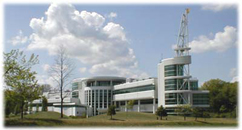|
|
Qilong Min
Atmospheric Sciences Research Center |
Research Interests:Climate change alters the radiation, temperature, sea surface pressure, and precipitation distributions, and also forces terrestrial vegetation and ecological systems to adapt. Great attention has being paid to potential aerosol impacts on cloud microphysical and radiative properties, as the indirect effect of aerosols currently produces the greatest uncertainty in climate predictions among all known climate forcing mechanisms. Large climate feedback uncertainties limit the accuracy in predicting the response of Earth´s climate to the atmospheric CO2 increase. Also, key physical and dynamical processes associated with severe weather (e.g., hurricanes and tornados) are neither fully understood nor characterized, and so high priority is placed on measurements that will contribute to successful forecasts of such events. To address several key issues, our research group works on the problems of atmospheric physics ranging from the ionosphere to the earth´s surface by using numerical models and active and passive remote sensing from multiple platforms (satellite, airborne, and surface-based). Our research efforts include: 1. Developing and improving radiative transfer models for the atmosphere, driven by the needs of Global Climate Models (GCMs) to predict changes in the energy budget and surface ultraviolet irradiances driven by anthropogenic trace gas emissions; 2. Developing remote sensing techniques by synergizing visible, infrared, and microwave measurements for understanding global climate, including retrievals of aerosol and cloud optical properties, terrestrial vegetation state and evaportranspiration; and precipitation and latent heat; 3. Improving various forecasting and climate models and integrating multi-platform observation and model simulations for understanding feedback mechanisms associated with water, energy, and carbon cycles, such as hurricane forecasting; aerosol-cloud-precipitation interaction; and atmosphere-terrestrial ecosystem exchange; 4. Developing various instruments, such as multi-scan spectral radiometers, a high-resolution oxygen A-band and water vapor band spectrometer (HAWS), and a DIfferential Absorption Radar for Barometry (DIAR-Bar) The Past and Current Projects:Photon path length distributions from high-resolution measurements of the Oxygen A-band (NSF) A regional climatology of cloud and aerosol for forest-atmosphere exchange (NIGEC/DOE) CloudSat Oxygen A-band retrieval algorithm development and calibration (CloudSat/NASA) The orbiting carbon observatory (OCO) level-2 retrieval algorithm development (OCO/NASA) Investigation of the Aerosol Indirect Effect at the Southern Great Plains and ARM Mobile Facility Using Ground Based Remote Sensors (NOAA&DOE, co-PI) NOAA Center for Atmospheric sciences at Howard University (EPP/NOAA) Development of high-resolution oxygen A-band spectrometer (ARM/DOE) Understanding and Improving CRM and GCM Simulations of Cloud Systems with ARM Observations (ARM/DOE, co-PI) Studying aerosol indirect effects on clouds using multi-platform measurements (BNL/DOE) Howard University Beltsville center for climate system observation (NASA) Impact and feasibility study of combined barometric pressure and wind profile measurements (LaRC/NASA) Retrievals of cloud optical properties and photon path length distribution using existing ARM data stream (ARM/DOE) |
|

